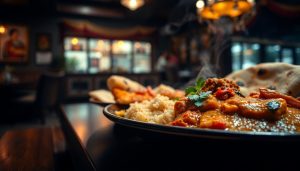Freshly baked bread, vibrant colors, and astonishing smells-this is where the Moroccan breakfast begins-it’s for the senses. Not just a meal, though, it is a time for families to reconnect while spending a bit slow time at the start of the day. Get ready to pleasantly trip into a whole world of new flavors. You’re going to be taken on a culinary tour through the tastes of Morocco!
Bread: The Heart of a Moroccan Breakfast
Bread is the quintessential Moroccan breakfast. It’s served with just about everything. There are tons of different varieties to try. Each one of them has a distinctive taste and texture. Let’s check out some popular choices!
Khobz (Moroccan Bread)
This is the bread of the everyday life in Morocco. It’s an oval loaf that’s slightly crusty outside but it’s soft inside. People consume it with everything. Perfect for scooping sauces or enjoying with cheese and olive oil. Regional differences provide unique twists, too.
Msemen (Square Pancakes)
Msemen are flaky, square pancakes. They are made by folding dough over and over, generating many thin layers in the dough. Usually, they are topped with honey and butter, but, sometimes, the filling includes onions or some spices.
Harcha (Semolina Bread)
Harcha is semolina bread. So it has a slightly grainy texture. Browned in a griddle until golden, Harcha can be consumed as is or topped with jams or cheese for an added touch of flavor.
Sweet Sensations: Honey, Jams, and Amlou
As sweet as they come, Moroccan breakfasts are co-operations between savory and sweet. Honey, jams, and amlou lend a sweetening touch to the meal. Let’s hear about these yummy delights.
Moroccan Honey
Morocco has fantastic honey. You might encounter bright, floral, and fruity orange blossom honey. Thyme honey would be a good alternative but more herbal-tasting. Each type of honey brings something different to it.
Homemade Jams and Preserves
Most moroccans do their own jams. Juniper berries, fig, apricots and other dates are some of the most common. Sweet and fruity, they add last touches to bread or msemen.
Amlou: Moroccan Nutella
Amlou is quite a yummy paste of almonds and argan oil which many call “the Moroccan nutella”. It is nutritious and very tasty, and mostly people eat it using bread. Smooth creamy texture goes well with harcha.
Savory Delights: Eggs, Cheese, and Olive Oil
The sweet counterbalances the savory. Eggs, cheese, and olive oil are common ingredients when preparing a Moroccan breakfast, which adds richness and flavor.
Eggs Tagine
Eggs tagine is an interesting dish; it boasts eggs cooked in tomato sauce with spices to enhance flavor and then vegetarians add other stuff to have fun with it. Most often, it is taken with bread through dipping.
Basic Tagine Recipe
Heat oil in pan, saute onions, garlic, in the oil, add in diced tomatoes, spices cumin, paprika, ginger and mix. Add tomato paste, and simmer till the sauce has thickened; create small wells in the sauce and break an egg into them. Cover and leave until the egg is set to your liking.
Khlea (Dried Meat)
This is fat-preserved, dried meat, a typical Moroccan dressing. Thumbnails-glossy, prepared by the traditional method of drying in the sun and then cooking in oil into a salty and chewy nibble, with a great taste addition to breakfast.
Olive Oil and Cheese
Moroccan olive oil boasts elegance. It serves great as a dip for bread. The local cheeses, either soft or firm, are great partners. They blend perfectly with olive oil and bread!
Beverages: Mint Tea and Coffee
A breakfast would not be formed without a drink. The couple is mint tea and coffee, mix a lot. They are regarded as a vital part of the meal.
Mint Tea
Mint tea has its great moments in Morocco: it is made from green tea, fresh mint, and sugar. It is served pouring the tea from above into the glasses for a foamy upper surface. Mint tea is a symbol of hospitality and friendship.
Coffee- Nuss Nuss
The Moroccans prefer coffee strong, and a popular version is “Nuss Nuss”, meaning half coffee and half milk. Another variation adds spices, like cinnamon.
Beyond The Basics: Regional Variations And Modern Twists
Breakfast varies across Morocco. For the coastal regions, breakfast could include some seafood. With modern influences altering the scene, it is always fun to see the diversity.
Breakfast in Marrakech
In Marrakech, you might come upon Tanjia, a slow-cooked meat dish in a clay pot. Searing hot, kept for long slow cooking, it renders the meat so tender.
Coastal Breakfast: Seafood Influences
From the coast can be fish grilled or seafood tagines for something to taste the ocean. It offers a fresh idea for breakfast.
Conclusion
A Moroccan breakfast is a tapestry of taste and texture. It typically would include bread, pastries, savory foods, and drinks. Breakfast is not just eating but bonding. Why not give it a try and make your Moroccan breakfast at home? You will love it!



